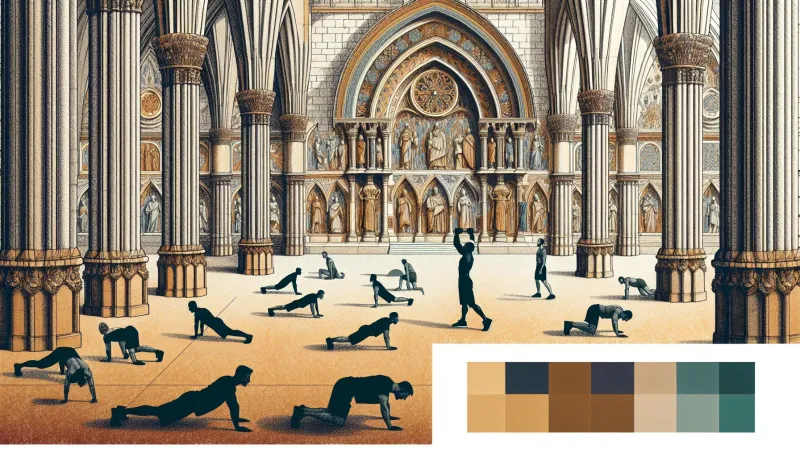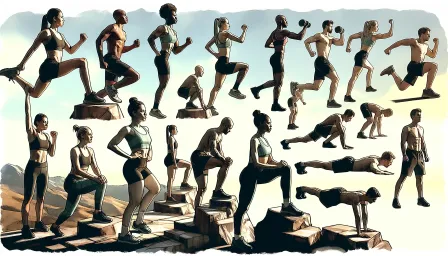Effective Strength Training Without Weights Exercises for Total Body Fitness

Learn how to effectively build strength without weights with these comprehensive and fact-based exercises. Achieve total body fitness without a gym.
Introduction
In today’s fast-paced world, not everyone has the time or resources to visit a gym regularly. But, the good news is that you don’t need expensive equipment or a gym membership to build and maintain strength. Strength training without weights is not only possible but also highly effective. This article delves into the various ways you can achieve total body fitness using bodyweight exercises, targeting different muscle groups and providing a comprehensive guide for those looking to enhance their strength without any equipment.
The Science of Strength Training Without Weights
Strength training without weights, also known as bodyweight training, utilizes your own body mass to provide resistance against gravity. This method can enhance muscular strength, endurance, flexibility, and core stability. The fundamental principle here is progressive overload – continually challenging the muscles to improve their capacity by increasing the difficulty or volume of the exercises over time.
Upper Body Exercises
Push-Ups
Push-ups are a quintessential bodyweight exercise that targets the chest, shoulders, triceps, and core. To execute a proper push-up, start in a plank position with hands slightly wider than shoulder-width apart. Lower your body until your chest nearly touches the floor, keeping your back flat and core engaged. Push back up to the starting position. Variations like incline push-ups, decline push-ups, or diamond push-ups can increase the difficulty.
Pull-Ups and Chin-Ups
For those with access to a sturdy bar, pull-ups and chin-ups are excellent for working the back, biceps, and shoulders. A pull-up involves an overhand grip while a chin-up uses an underhand grip. If a bar isn’t available, alternatives like inverted rows using a table or doorframe rows can mimic these movements.
Lower Body Exercises
Squats
Squats are fundamental for building lower body strength, targeting the quadriceps, hamstrings, glutes, and calves. Start with your feet shoulder-width apart, chest up, and back straight. Push your hips back and bend your knees to lower your body as if sitting into a chair, then drive through your heels to return to the starting position. Variations include jump squats for plyometric benefit and pistol squats for a single-leg challenge.
Lunges
Lunges are versatile and effective for strengthening the legs and improving balance. Begin standing, then take a big step forward with one leg and lower your hips until both knees are bent at about 90 degrees. Push back to the starting position and repeat on the opposite leg. Variations like walking lunges, reverse lunges, and lateral lunges engage different muscle groups.
Core Strengthening Exercises
Planks
Planks are a highly effective exercise for strengthening the core. Assume a push-up position but rest on your forearms instead of your hands. Keep your body in a straight line from head to heels, engaging your core to avoid sagging or arching your back. Hold this position for as long as possible. Side planks and plank variations like the shoulder tap plank add an extra challenge.
Leg Raises
Leg raises target the lower abdominal muscles. Lie on your back with your legs straight and hands by your sides. Lift your legs until they are perpendicular to the floor, then slowly lower them back down without touching the ground. To increase difficulty, try holding a hollow body position or performing a flutter kick.
Full Body Exercises
Burpees
Burpees are a full-body exercise that combines a squat, push-up, and jump, making it a comprehensive workout. Begin standing, drop into a squat position with your hands on the ground, kick your feet back into a push-up position, complete a push-up, return your feet to the squat position, and jump up with arms extended.
Mountain Climbers
Mountain climbers are dynamic exercises that engage the entire body. Start in a plank position, then quickly draw one knee up towards your chest while keeping the other leg extended. Alternate legs rapidly, mimicking a climbing motion. This exercise builds strength and boosts cardiovascular fitness simultaneously.
Tips for Effective Bodyweight Training
Consistency is Key
Consistency in any workout routine is essential. Dedicate specific days and times each week to your bodyweight training, adjusting as necessary to fit your schedule but maintaining a regular habit.
Form Over Quantity
Proper form is crucial to avoid injuries and gain the benefits of each exercise. Focus on performing each movement with correct technique rather than rushing through reps. Quality always trumps quantity.
Progressive Overload
To continue improving, gradually increase the difficulty of exercises or the number of repetitions. This might include adding pause reps, plyometric elements, or transitioning to more challenging variations of each exercise.
Listen to Your Body
Pay attention to how your body responds to the exercises. Rest when needed and modify exercises if you experience pain or discomfort. Incorporate rest days to allow your muscles to recover and grow.
Conclusion
Strength training without weights is an effective, accessible, and versatile way to enhance your fitness. By incorporating various bodyweight exercises, you can target different muscle groups and achieve total body fitness. Remember, consistency, proper form, and progressive overload are vital to your success. With dedication and the right approach, you can build a strong, resilient body without ever stepping foot in a gym.



























